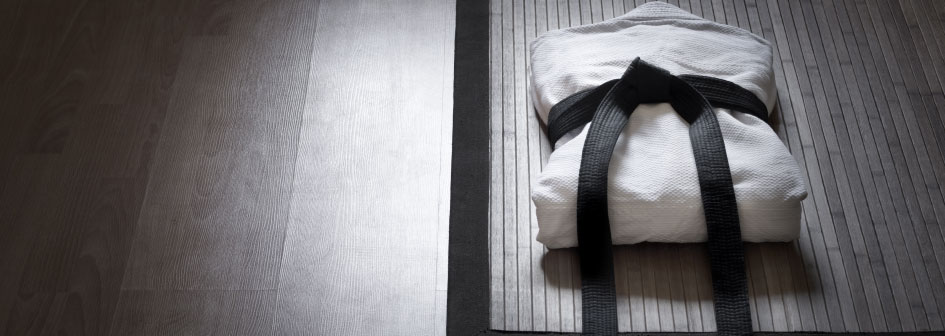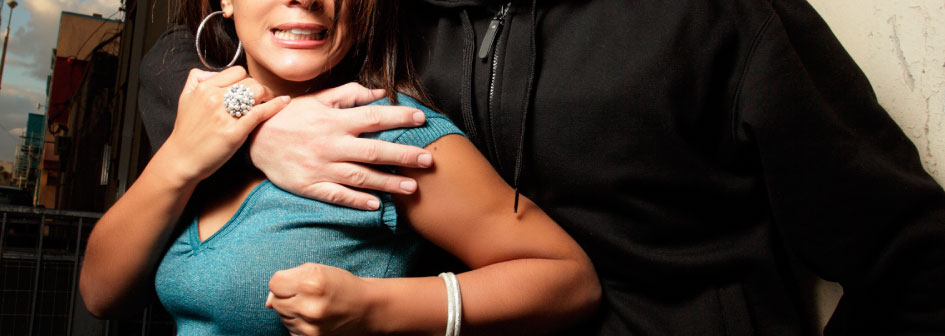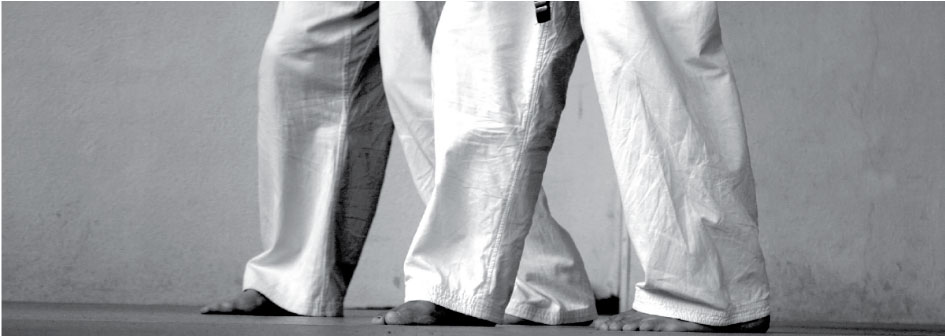Aikido Glossary
A
- Aihanmi (eye-hahn-mhee): same-side stance
- Aikido (eye-khee-doh): art founded by Morihei Ueshiba (O-Sensei), the way of Aiki
- Aikidoka (eye-khee-doh-kah): Aikido practitioner
- Aikiotoshi (eye-khee-oh-toh-shee): Aiki drop
- Aiuchi (eye-oo-chee): mutual destruction
- Atemi (ah-tey-mhee): a strike to an opening
B
- Bokken (boh-keyn): wooden practice sword
- Budo (boo-doh): martial way
- Budoka (boo-doh-kah): martial arts practitioner
- Bushi (boo-shee): warrior
- Bushido (boo-shee-doh): the way of the warrior
C
- Chi (chee): earth
D
- Dan (dahn): degree (black belt rank)
- Deshi (dey-shee): a student, a disciple
- Do (doh): way, path
- Dogi (doh-gee): practice uniform
- Dojo (doh-joh): place where one studies a "do" or way
- Domo Arigato Gozaimashita (doh-moh ah-ree-gah-toh goh-zeye-mahsh-tah): thank you very much
- Doshu (doh-shoo): the person who shows the way; current leader of Aikikai Aikido
G
- Gokyo (goh-khee-oh): fifth teaching, fifth movement
- Gyakuhanmi (ghee-ah-khoo-hahn-mhee): opposite-side stance
H
- Hakama (hah-kah-mah): traditional pleated pants worn by the samurai and by budoka
- Hanmi (hahn-mhee): the basic triangular stance of Aikido (Aihanmi is "same stance"; Gyakuhanmi is "opposite stance")
- Hanmihandachi (hahn-mhee-hahn-dah-chee): technique is which nage is seated and uke is standing
- Hara (hah-rhah): one's center, found two fingers width below the navel
- Henkawaza (heyn-kah-wah-zah): changing from one technique to another
- Hiji (hee-jhee): elbow
- Hijiate (hee-jhee-ah-tey): applying pressure against the elbow
- Hijitori (hee-jhee-toh-rhee): elbow grab
- Hombu Dojo (hohm-boo doh-joh): the international headquarters of Aikido located in Tokyo, Japan
I
- Ichi (ee-chee): one or first
- Ikkyo (ee-khee-oh): the first teaching, the first movement
- Irimi (ee-rhee-mhee): the act of entering directly into the attack, entering with the body
- Iriminage (ee-rhee-mhee-nah-ghey): a throw whose main component is the irimi entrance
J
- Jiyuwaza (jhee-oo-wah-zah): free-style practice
- Jo (joh): short wooden staff usually 50-54 inches in length
K
- Kaeshiwaza (khuy-shee-wah-zah): reversal technique
- Kaiten (kye-teyn): pivot requiring turning of the hips
- Kaitenage (kye-teyn-nah-ghey): revolving throw
- Kami (kah-mhee): God(s) or Spirit(s)
- Kamiza (kah-mhee-zah): Altar
- Katatori (kah-tah-toh-rhee): shoulder grab
- Katatetori (kah-tah-tey-toh-rhee): one-hand grab
- Keiko (khey-koh): practice
- Ken (kheyn): sword
- Kenjutsu (kheyn-joot-soo): sword techniques
- Kesagiri (khey-sah-ghee-rhee): diagonal cut across the body
- Ki (khee): life energy
- Kokyu (koh-khee-oo): breath or breathing
- Kokyuho / Kokyudosa (koh-khee-oo-hoh / koh-khee-oo-doh-sah): an exercise in blending your energy with that of your partner
- Kokyunage (koh-khee-oo-nah-ghey): Breath throw
- Kosatori (koh-sah-toh-rhee): cross-hand grab
- Koshinage (koh-shee-nah-ghey): hip throw
- Kotegaeshi (koh-tey-ghuy-shee): wrist twist
- Kubishime (koo-bee-shee-mhey): choke hold
- Kumitachi (koo-mhee-tah-chee): paired sword practice
- Kyu (khee-oo): grades preceeding yudansha rank
M
- Maai (mah-eye): distance, separation
- Mae (mhuy): front
- Misogi (mhee-soh-ghee): spiritual cleansing
- Morotetori (moh-rhoh-tey-toh-rhee): grabbing one hand with two hands
- Munetsuki (moo-ney-tskee): a strike or thrust to the upper body
- Musubi (moo-soo-bhee): connect
N
- Nage (nah-ghey): a throw, one who throws (opposite of uke)
- Nikyo (nhee-khee-oh): second teaching, second movement
O
- Omote (oh-moh-tey): to the front
- Onegaishimasu (oh-nhey-gye-shee-mahs): please (used when bowing to partner before practise)
- O-Sensei (oh-sen-sey): great teacher
- Otoshi (oh-toh-shee): a drop, a throw
R
- Randori (rahn-doh-rhee): multiple-attack practice
- Ryokatatori (rhee-oh-kah-tah-toh-rhee): two-shoulder grab
- Ryotetori (rhee-oh-tey-toh-rhee): two-hand grab (two hands grabbing two hands)
- Ryu (rhee-oo): a school or a style
S
- Sankyo (sahn-khee-oh): third teaching, third movement
- Seiza (sey-zah): traditional Japanese seated position
- Sensei (sen-sey): a teacher, one who gives guidance
- Shidoin (shee-doh-een): senior instructor
- Shihan (shee-hahn): teacher who presides over region
- Shihonage (shee-hoh-nah-ghey): four-direction throw
- Shikko (shee-koh): walking on one's knees
- Shomen (shoh-meyn): the head, the front
- Shomenuchi (shoh-meyn-oo-chee): strike to the front of the head
- Soto (soh-toh): outside; opposite of uchi
- Suburi (soo-boo-rhee): repititious motion performed to perfect movement
- Sumiotoshi (soo-mhee-oh-toh-shee): corner drop
- Suwariwaza (soo-wah-rhee-wah-zah): seated technique
T
- Tachi (tah-chee): sword
- Tachiwaza (tah-chee-wah-zah): standing technique
- Taisabaki (tye-sah-bah-khee): evasive body movement
- Tegatana (tey-gah-tah-nah): hand blade
- Ten (teyn): heaven
- Tenchinage (teyn-chee-nah-ghey): heaven-and-earth throw
- Tatami (tah-tah-mhee): traditional Japanese straw mats
- Tenkan (teyn-kahn): 180 degree pivot on the front foot
- Tori (toh-rhee): a grab, a hold
- Tsuki (tskee): thrust or punch
U
- Uchi (oo-chee): inside; opposite of soto
- Uchideshi (oo-chee-dey-shee): live-in student or disciple
- Udegarami (oo-dey-gah-rhah-mhee): arm entwinement technique
- Udekimenage (oo-dey-khee-mey-nah-ghey): a throw applying pressure against the elbow
- Ueshiba Morihei (Oo-eh-she-bah Moh-rhee-hey): founder of Aikido, referred to as O-Sensei
- Ueshiba Kisshomaru (Oo-eh-shee-bah Khee-shoh-mah-rhoo): 2nd Doshu, O-Sensei's son
- Ueshiba Moriteru (Oo-eh-shee-bah Moh-rhee-tey-rhoo): 3rd Doshu, O-Sensei's grandson
- Uke (oo-khey): one who receives the force, the person who is thrown (opposite of nage)
- Ukemi (oo-khey-mhee): the art of falling
- Ura (oo-rha): back, to the rear
- Ushiro (oo-shee-rhoh): behind
- Ushirotekubitori (oo-shee-rhoh-tey-khoo-bhee-toh-rhee): wrist grab from behind
- Ushirowaza (oo-shee-rhoh-wah-zah): techniques in which one is attacked from behind
W
- Waza (wah-zah): techniques
Y
- Yokomen (yoh-koh-meyn): to the side
- Yokomenuchi (yoh-koh-meyn-oo-chee): strike or cut to the side of the head
- Yonkyo (yohn-khee-oh): fourth teaching, fourth movement
- Yudansha (yhoo-dahn-shah): those who have achieved black-belt level
Links
- Aikikai Foundation - World Aikido Headquarters
- International Aikido Federation
- United States Aikido Federation
- New York Aikikai
- USAF Aikido News
- Aikido of Center City
- Aikido of Upland
- Aikido Online
- Aiki Web
- Aikido Journal
- Aiki.com
- Aikido FAQ
- Aikido WOrld Journal
- Diamond State Aikido


